Comprehensive Analysis of Islamic Finance Principles and Practices
VerifiedAdded on 2020/05/16
|9
|2322
|692
Homework Assignment
AI Summary
This assignment provides a comprehensive overview of Islamic finance, addressing Sharia compliance, the prohibition of riba (interest), and the adaptation of Islamic financial practices to modern technologies. It explores key concepts such as Mudaraba and Musharaka contracts as alternatives to conventional interest-based financing, detailing their structures and risk-sharing mechanisms. The assignment further examines Sukuk (Islamic bonds), including different structures and their viability based on underlying assets. It also discusses the role of Sharia boards and scholars in ensuring compliance, the use of LIBOR alternatives, and the ethical considerations in Islamic finance, such as screening investments. The document highlights the importance of risk management and the application of Islamic finance in various financial instruments and partnerships. Finally, the assignment covers the role of financial institutions and the importance of Sharia compliance in the context of Islamic financial transactions and the prevention of unethical practices.
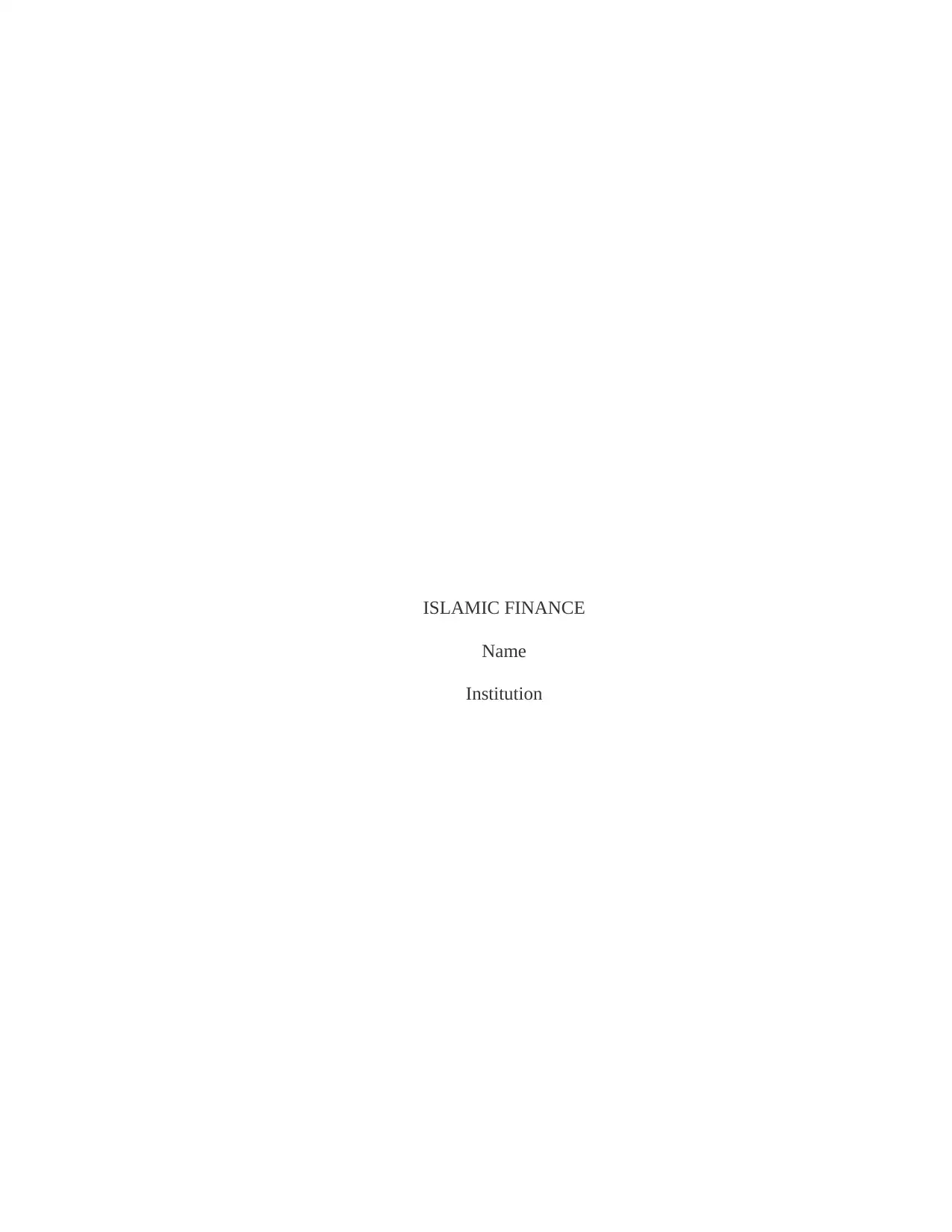
ISLAMIC FINANCE
Name
Institution
Name
Institution
Paraphrase This Document
Need a fresh take? Get an instant paraphrase of this document with our AI Paraphraser
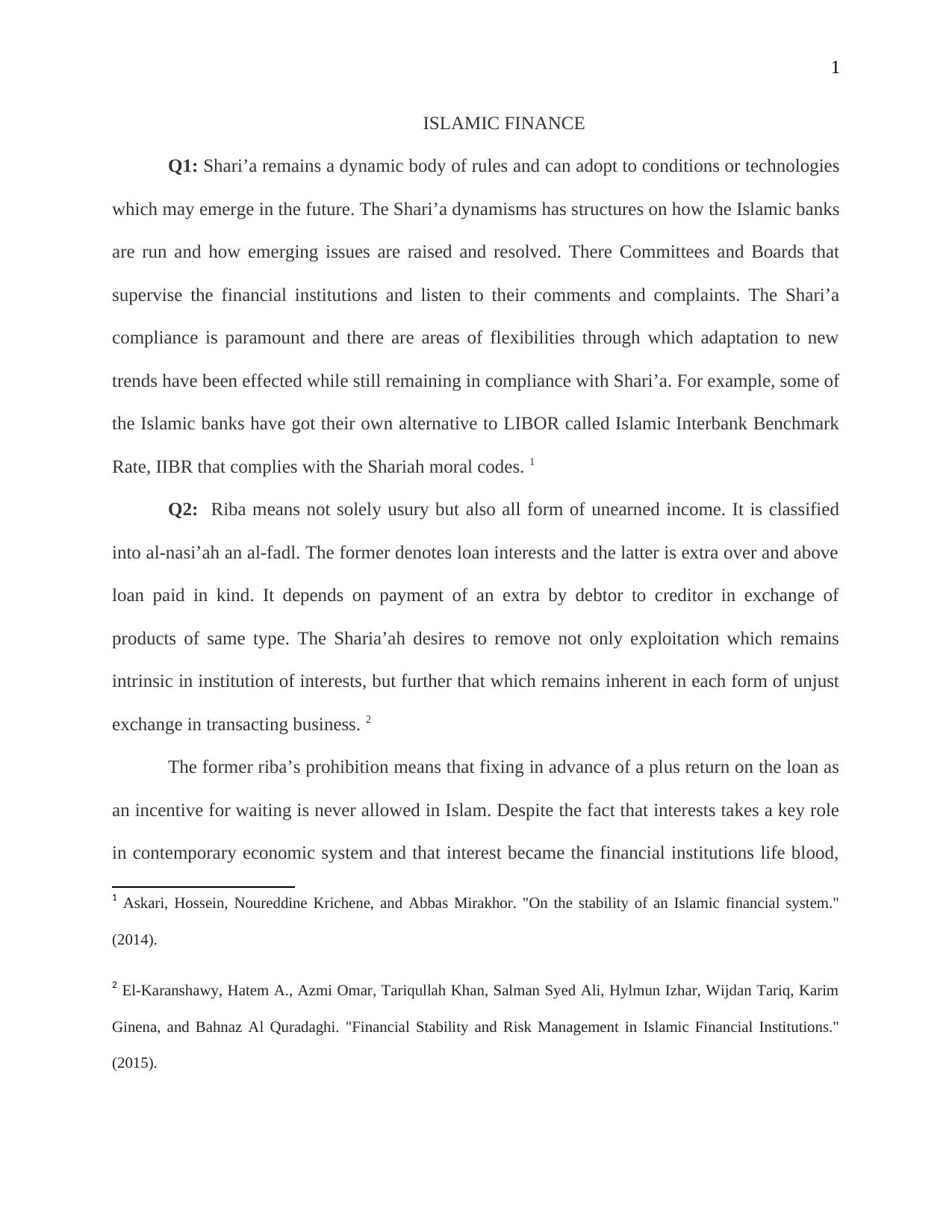
1
ISLAMIC FINANCE
Q1: Shari’a remains a dynamic body of rules and can adopt to conditions or technologies
which may emerge in the future. The Shari’a dynamisms has structures on how the Islamic banks
are run and how emerging issues are raised and resolved. There Committees and Boards that
supervise the financial institutions and listen to their comments and complaints. The Shari’a
compliance is paramount and there are areas of flexibilities through which adaptation to new
trends have been effected while still remaining in compliance with Shari’a. For example, some of
the Islamic banks have got their own alternative to LIBOR called Islamic Interbank Benchmark
Rate, IIBR that complies with the Shariah moral codes. 1
Q2: Riba means not solely usury but also all form of unearned income. It is classified
into al-nasi’ah an al-fadl. The former denotes loan interests and the latter is extra over and above
loan paid in kind. It depends on payment of an extra by debtor to creditor in exchange of
products of same type. The Sharia’ah desires to remove not only exploitation which remains
intrinsic in institution of interests, but further that which remains inherent in each form of unjust
exchange in transacting business. 2
The former riba’s prohibition means that fixing in advance of a plus return on the loan as
an incentive for waiting is never allowed in Islam. Despite the fact that interests takes a key role
in contemporary economic system and that interest became the financial institutions life blood,
1 Askari, Hossein, Noureddine Krichene, and Abbas Mirakhor. "On the stability of an Islamic financial system."
(2014).
2 El-Karanshawy, Hatem A., Azmi Omar, Tariqullah Khan, Salman Syed Ali, Hylmun Izhar, Wijdan Tariq, Karim
Ginena, and Bahnaz Al Quradaghi. "Financial Stability and Risk Management in Islamic Financial Institutions."
(2015).
ISLAMIC FINANCE
Q1: Shari’a remains a dynamic body of rules and can adopt to conditions or technologies
which may emerge in the future. The Shari’a dynamisms has structures on how the Islamic banks
are run and how emerging issues are raised and resolved. There Committees and Boards that
supervise the financial institutions and listen to their comments and complaints. The Shari’a
compliance is paramount and there are areas of flexibilities through which adaptation to new
trends have been effected while still remaining in compliance with Shari’a. For example, some of
the Islamic banks have got their own alternative to LIBOR called Islamic Interbank Benchmark
Rate, IIBR that complies with the Shariah moral codes. 1
Q2: Riba means not solely usury but also all form of unearned income. It is classified
into al-nasi’ah an al-fadl. The former denotes loan interests and the latter is extra over and above
loan paid in kind. It depends on payment of an extra by debtor to creditor in exchange of
products of same type. The Sharia’ah desires to remove not only exploitation which remains
intrinsic in institution of interests, but further that which remains inherent in each form of unjust
exchange in transacting business. 2
The former riba’s prohibition means that fixing in advance of a plus return on the loan as
an incentive for waiting is never allowed in Islam. Despite the fact that interests takes a key role
in contemporary economic system and that interest became the financial institutions life blood,
1 Askari, Hossein, Noureddine Krichene, and Abbas Mirakhor. "On the stability of an Islamic financial system."
(2014).
2 El-Karanshawy, Hatem A., Azmi Omar, Tariqullah Khan, Salman Syed Ali, Hylmun Izhar, Wijdan Tariq, Karim
Ginena, and Bahnaz Al Quradaghi. "Financial Stability and Risk Management in Islamic Financial Institutions."
(2015).
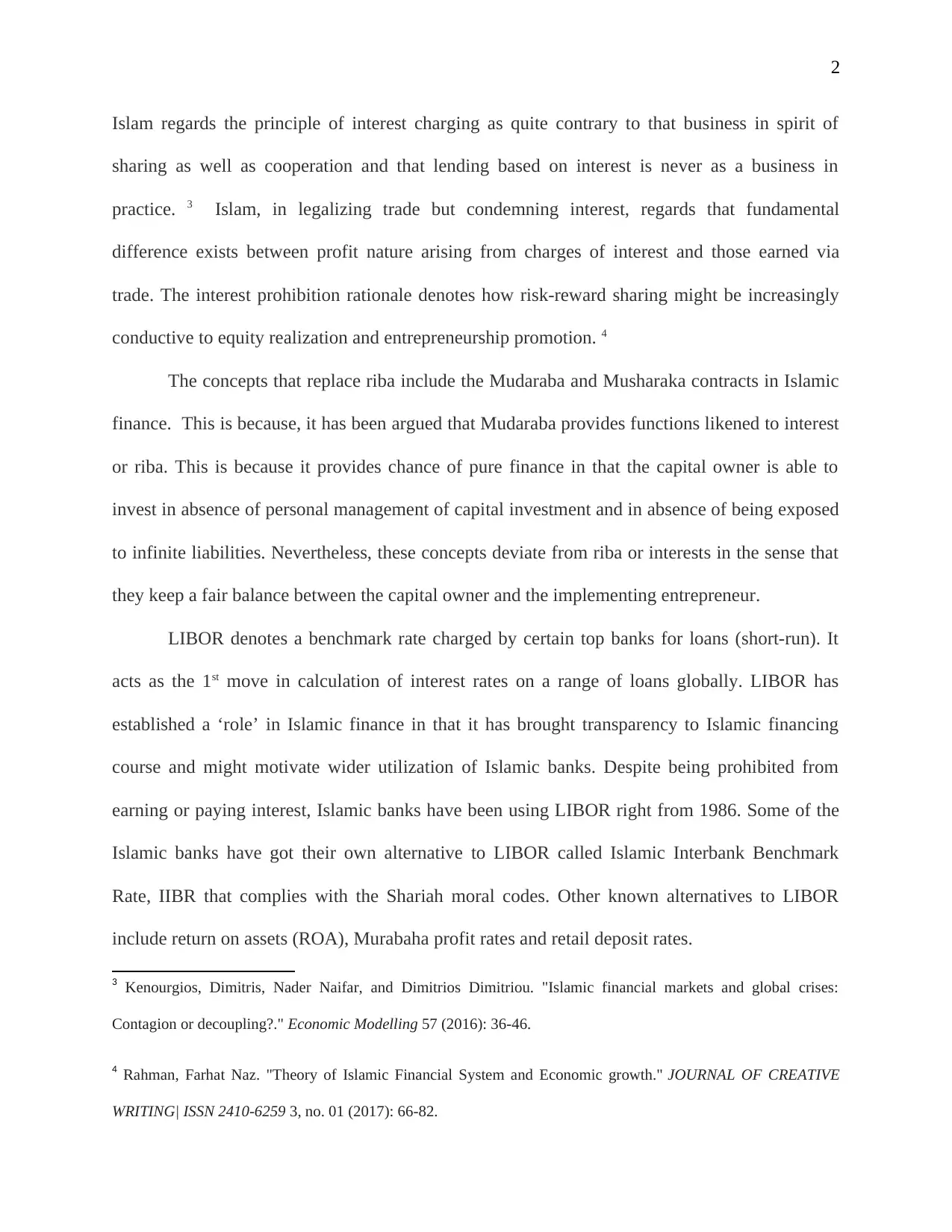
2
Islam regards the principle of interest charging as quite contrary to that business in spirit of
sharing as well as cooperation and that lending based on interest is never as a business in
practice. 3 Islam, in legalizing trade but condemning interest, regards that fundamental
difference exists between profit nature arising from charges of interest and those earned via
trade. The interest prohibition rationale denotes how risk-reward sharing might be increasingly
conductive to equity realization and entrepreneurship promotion. 4
The concepts that replace riba include the Mudaraba and Musharaka contracts in Islamic
finance. This is because, it has been argued that Mudaraba provides functions likened to interest
or riba. This is because it provides chance of pure finance in that the capital owner is able to
invest in absence of personal management of capital investment and in absence of being exposed
to infinite liabilities. Nevertheless, these concepts deviate from riba or interests in the sense that
they keep a fair balance between the capital owner and the implementing entrepreneur.
LIBOR denotes a benchmark rate charged by certain top banks for loans (short-run). It
acts as the 1st move in calculation of interest rates on a range of loans globally. LIBOR has
established a ‘role’ in Islamic finance in that it has brought transparency to Islamic financing
course and might motivate wider utilization of Islamic banks. Despite being prohibited from
earning or paying interest, Islamic banks have been using LIBOR right from 1986. Some of the
Islamic banks have got their own alternative to LIBOR called Islamic Interbank Benchmark
Rate, IIBR that complies with the Shariah moral codes. Other known alternatives to LIBOR
include return on assets (ROA), Murabaha profit rates and retail deposit rates.
3 Kenourgios, Dimitris, Nader Naifar, and Dimitrios Dimitriou. "Islamic financial markets and global crises:
Contagion or decoupling?." Economic Modelling 57 (2016): 36-46.
4 Rahman, Farhat Naz. "Theory of Islamic Financial System and Economic growth." JOURNAL OF CREATIVE
WRITING| ISSN 2410-6259 3, no. 01 (2017): 66-82.
Islam regards the principle of interest charging as quite contrary to that business in spirit of
sharing as well as cooperation and that lending based on interest is never as a business in
practice. 3 Islam, in legalizing trade but condemning interest, regards that fundamental
difference exists between profit nature arising from charges of interest and those earned via
trade. The interest prohibition rationale denotes how risk-reward sharing might be increasingly
conductive to equity realization and entrepreneurship promotion. 4
The concepts that replace riba include the Mudaraba and Musharaka contracts in Islamic
finance. This is because, it has been argued that Mudaraba provides functions likened to interest
or riba. This is because it provides chance of pure finance in that the capital owner is able to
invest in absence of personal management of capital investment and in absence of being exposed
to infinite liabilities. Nevertheless, these concepts deviate from riba or interests in the sense that
they keep a fair balance between the capital owner and the implementing entrepreneur.
LIBOR denotes a benchmark rate charged by certain top banks for loans (short-run). It
acts as the 1st move in calculation of interest rates on a range of loans globally. LIBOR has
established a ‘role’ in Islamic finance in that it has brought transparency to Islamic financing
course and might motivate wider utilization of Islamic banks. Despite being prohibited from
earning or paying interest, Islamic banks have been using LIBOR right from 1986. Some of the
Islamic banks have got their own alternative to LIBOR called Islamic Interbank Benchmark
Rate, IIBR that complies with the Shariah moral codes. Other known alternatives to LIBOR
include return on assets (ROA), Murabaha profit rates and retail deposit rates.
3 Kenourgios, Dimitris, Nader Naifar, and Dimitrios Dimitriou. "Islamic financial markets and global crises:
Contagion or decoupling?." Economic Modelling 57 (2016): 36-46.
4 Rahman, Farhat Naz. "Theory of Islamic Financial System and Economic growth." JOURNAL OF CREATIVE
WRITING| ISSN 2410-6259 3, no. 01 (2017): 66-82.
⊘ This is a preview!⊘
Do you want full access?
Subscribe today to unlock all pages.

Trusted by 1+ million students worldwide
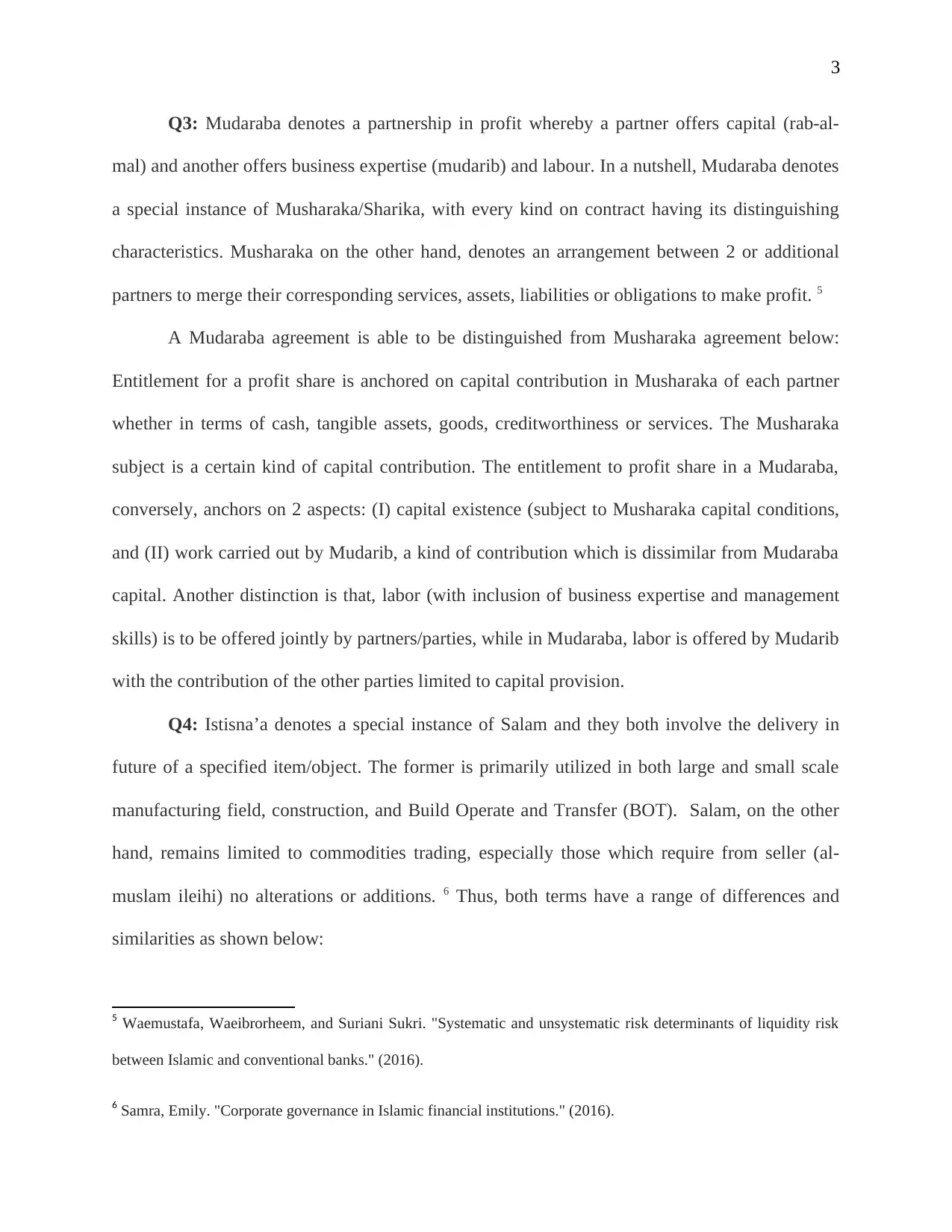
3
Q3: Mudaraba denotes a partnership in profit whereby a partner offers capital (rab-al-
mal) and another offers business expertise (mudarib) and labour. In a nutshell, Mudaraba denotes
a special instance of Musharaka/Sharika, with every kind on contract having its distinguishing
characteristics. Musharaka on the other hand, denotes an arrangement between 2 or additional
partners to merge their corresponding services, assets, liabilities or obligations to make profit. 5
A Mudaraba agreement is able to be distinguished from Musharaka agreement below:
Entitlement for a profit share is anchored on capital contribution in Musharaka of each partner
whether in terms of cash, tangible assets, goods, creditworthiness or services. The Musharaka
subject is a certain kind of capital contribution. The entitlement to profit share in a Mudaraba,
conversely, anchors on 2 aspects: (I) capital existence (subject to Musharaka capital conditions,
and (II) work carried out by Mudarib, a kind of contribution which is dissimilar from Mudaraba
capital. Another distinction is that, labor (with inclusion of business expertise and management
skills) is to be offered jointly by partners/parties, while in Mudaraba, labor is offered by Mudarib
with the contribution of the other parties limited to capital provision.
Q4: Istisna’a denotes a special instance of Salam and they both involve the delivery in
future of a specified item/object. The former is primarily utilized in both large and small scale
manufacturing field, construction, and Build Operate and Transfer (BOT). Salam, on the other
hand, remains limited to commodities trading, especially those which require from seller (al-
muslam ileihi) no alterations or additions. 6 Thus, both terms have a range of differences and
similarities as shown below:
5 Waemustafa, Waeibrorheem, and Suriani Sukri. "Systematic and unsystematic risk determinants of liquidity risk
between Islamic and conventional banks." (2016).
6 Samra, Emily. "Corporate governance in Islamic financial institutions." (2016).
Q3: Mudaraba denotes a partnership in profit whereby a partner offers capital (rab-al-
mal) and another offers business expertise (mudarib) and labour. In a nutshell, Mudaraba denotes
a special instance of Musharaka/Sharika, with every kind on contract having its distinguishing
characteristics. Musharaka on the other hand, denotes an arrangement between 2 or additional
partners to merge their corresponding services, assets, liabilities or obligations to make profit. 5
A Mudaraba agreement is able to be distinguished from Musharaka agreement below:
Entitlement for a profit share is anchored on capital contribution in Musharaka of each partner
whether in terms of cash, tangible assets, goods, creditworthiness or services. The Musharaka
subject is a certain kind of capital contribution. The entitlement to profit share in a Mudaraba,
conversely, anchors on 2 aspects: (I) capital existence (subject to Musharaka capital conditions,
and (II) work carried out by Mudarib, a kind of contribution which is dissimilar from Mudaraba
capital. Another distinction is that, labor (with inclusion of business expertise and management
skills) is to be offered jointly by partners/parties, while in Mudaraba, labor is offered by Mudarib
with the contribution of the other parties limited to capital provision.
Q4: Istisna’a denotes a special instance of Salam and they both involve the delivery in
future of a specified item/object. The former is primarily utilized in both large and small scale
manufacturing field, construction, and Build Operate and Transfer (BOT). Salam, on the other
hand, remains limited to commodities trading, especially those which require from seller (al-
muslam ileihi) no alterations or additions. 6 Thus, both terms have a range of differences and
similarities as shown below:
5 Waemustafa, Waeibrorheem, and Suriani Sukri. "Systematic and unsystematic risk determinants of liquidity risk
between Islamic and conventional banks." (2016).
6 Samra, Emily. "Corporate governance in Islamic financial institutions." (2016).
Paraphrase This Document
Need a fresh take? Get an instant paraphrase of this document with our AI Paraphraser
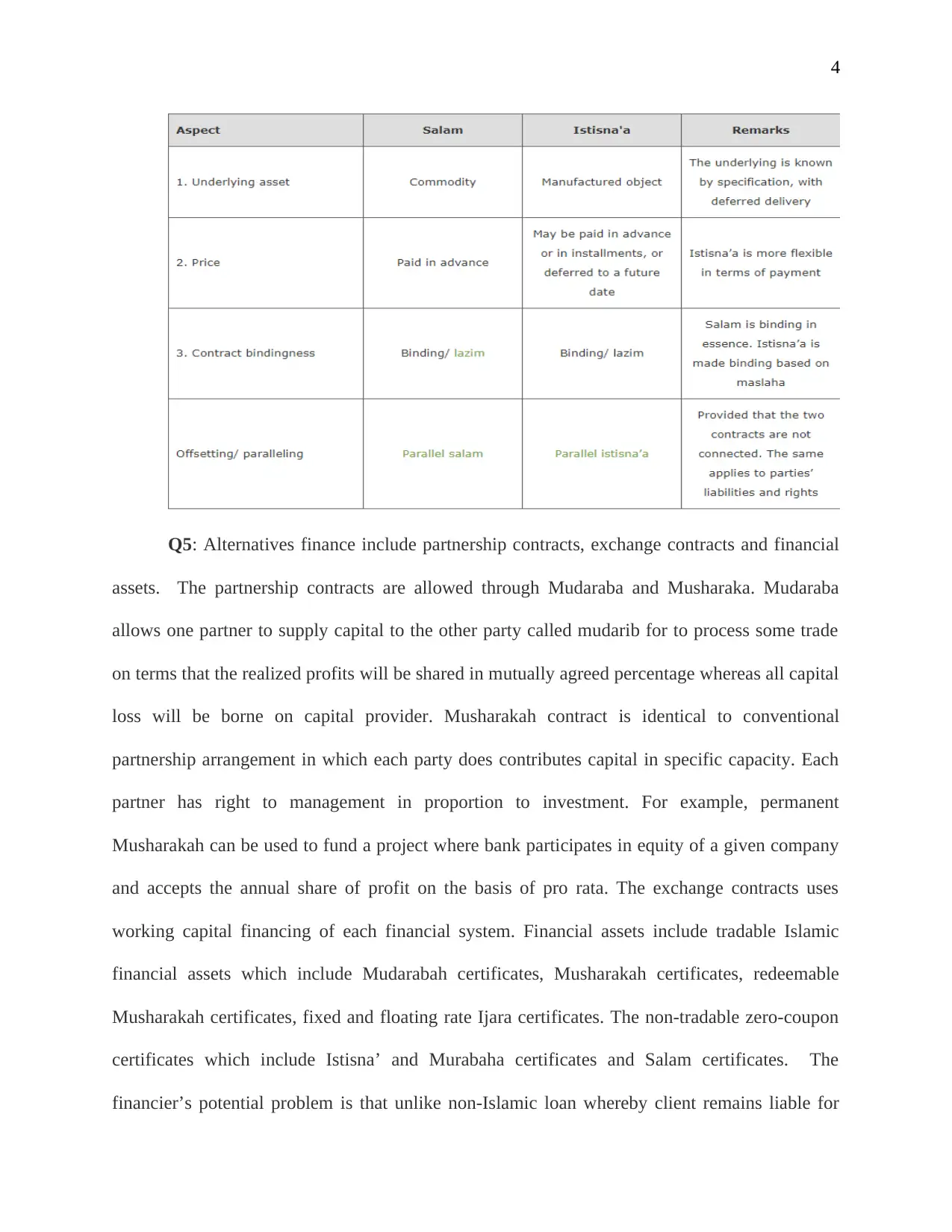
4
Q5: Alternatives finance include partnership contracts, exchange contracts and financial
assets. The partnership contracts are allowed through Mudaraba and Musharaka. Mudaraba
allows one partner to supply capital to the other party called mudarib for to process some trade
on terms that the realized profits will be shared in mutually agreed percentage whereas all capital
loss will be borne on capital provider. Musharakah contract is identical to conventional
partnership arrangement in which each party does contributes capital in specific capacity. Each
partner has right to management in proportion to investment. For example, permanent
Musharakah can be used to fund a project where bank participates in equity of a given company
and accepts the annual share of profit on the basis of pro rata. The exchange contracts uses
working capital financing of each financial system. Financial assets include tradable Islamic
financial assets which include Mudarabah certificates, Musharakah certificates, redeemable
Musharakah certificates, fixed and floating rate Ijara certificates. The non-tradable zero-coupon
certificates which include Istisna’ and Murabaha certificates and Salam certificates. The
financier’s potential problem is that unlike non-Islamic loan whereby client remains liable for
Q5: Alternatives finance include partnership contracts, exchange contracts and financial
assets. The partnership contracts are allowed through Mudaraba and Musharaka. Mudaraba
allows one partner to supply capital to the other party called mudarib for to process some trade
on terms that the realized profits will be shared in mutually agreed percentage whereas all capital
loss will be borne on capital provider. Musharakah contract is identical to conventional
partnership arrangement in which each party does contributes capital in specific capacity. Each
partner has right to management in proportion to investment. For example, permanent
Musharakah can be used to fund a project where bank participates in equity of a given company
and accepts the annual share of profit on the basis of pro rata. The exchange contracts uses
working capital financing of each financial system. Financial assets include tradable Islamic
financial assets which include Mudarabah certificates, Musharakah certificates, redeemable
Musharakah certificates, fixed and floating rate Ijara certificates. The non-tradable zero-coupon
certificates which include Istisna’ and Murabaha certificates and Salam certificates. The
financier’s potential problem is that unlike non-Islamic loan whereby client remains liable for
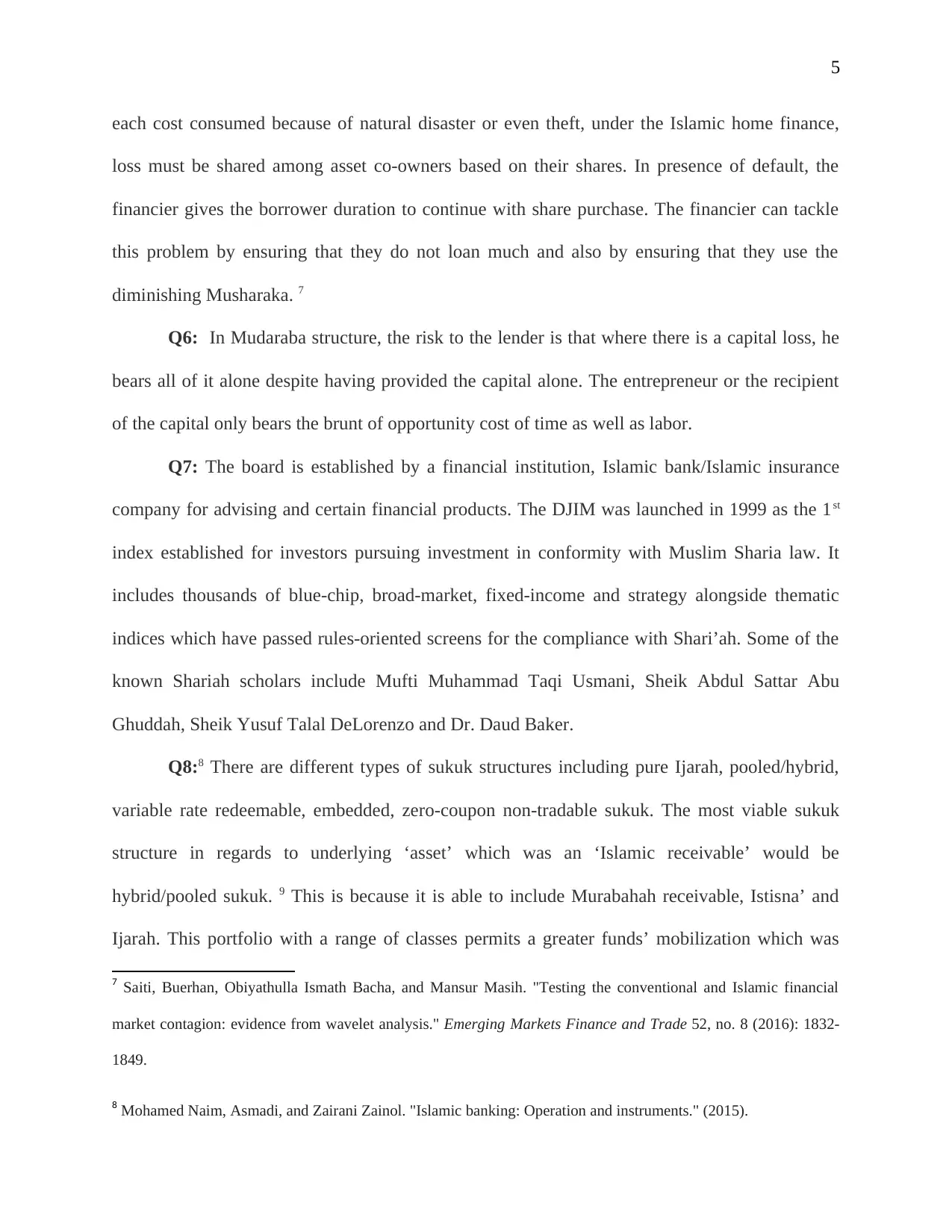
5
each cost consumed because of natural disaster or even theft, under the Islamic home finance,
loss must be shared among asset co-owners based on their shares. In presence of default, the
financier gives the borrower duration to continue with share purchase. The financier can tackle
this problem by ensuring that they do not loan much and also by ensuring that they use the
diminishing Musharaka. 7
Q6: In Mudaraba structure, the risk to the lender is that where there is a capital loss, he
bears all of it alone despite having provided the capital alone. The entrepreneur or the recipient
of the capital only bears the brunt of opportunity cost of time as well as labor.
Q7: The board is established by a financial institution, Islamic bank/Islamic insurance
company for advising and certain financial products. The DJIM was launched in 1999 as the 1st
index established for investors pursuing investment in conformity with Muslim Sharia law. It
includes thousands of blue-chip, broad-market, fixed-income and strategy alongside thematic
indices which have passed rules-oriented screens for the compliance with Shari’ah. Some of the
known Shariah scholars include Mufti Muhammad Taqi Usmani, Sheik Abdul Sattar Abu
Ghuddah, Sheik Yusuf Talal DeLorenzo and Dr. Daud Baker.
Q8:8 There are different types of sukuk structures including pure Ijarah, pooled/hybrid,
variable rate redeemable, embedded, zero-coupon non-tradable sukuk. The most viable sukuk
structure in regards to underlying ‘asset’ which was an ‘Islamic receivable’ would be
hybrid/pooled sukuk. 9 This is because it is able to include Murabahah receivable, Istisna’ and
Ijarah. This portfolio with a range of classes permits a greater funds’ mobilization which was
7 Saiti, Buerhan, Obiyathulla Ismath Bacha, and Mansur Masih. "Testing the conventional and Islamic financial
market contagion: evidence from wavelet analysis." Emerging Markets Finance and Trade 52, no. 8 (2016): 1832-
1849.
8 Mohamed Naim, Asmadi, and Zairani Zainol. "Islamic banking: Operation and instruments." (2015).
each cost consumed because of natural disaster or even theft, under the Islamic home finance,
loss must be shared among asset co-owners based on their shares. In presence of default, the
financier gives the borrower duration to continue with share purchase. The financier can tackle
this problem by ensuring that they do not loan much and also by ensuring that they use the
diminishing Musharaka. 7
Q6: In Mudaraba structure, the risk to the lender is that where there is a capital loss, he
bears all of it alone despite having provided the capital alone. The entrepreneur or the recipient
of the capital only bears the brunt of opportunity cost of time as well as labor.
Q7: The board is established by a financial institution, Islamic bank/Islamic insurance
company for advising and certain financial products. The DJIM was launched in 1999 as the 1st
index established for investors pursuing investment in conformity with Muslim Sharia law. It
includes thousands of blue-chip, broad-market, fixed-income and strategy alongside thematic
indices which have passed rules-oriented screens for the compliance with Shari’ah. Some of the
known Shariah scholars include Mufti Muhammad Taqi Usmani, Sheik Abdul Sattar Abu
Ghuddah, Sheik Yusuf Talal DeLorenzo and Dr. Daud Baker.
Q8:8 There are different types of sukuk structures including pure Ijarah, pooled/hybrid,
variable rate redeemable, embedded, zero-coupon non-tradable sukuk. The most viable sukuk
structure in regards to underlying ‘asset’ which was an ‘Islamic receivable’ would be
hybrid/pooled sukuk. 9 This is because it is able to include Murabahah receivable, Istisna’ and
Ijarah. This portfolio with a range of classes permits a greater funds’ mobilization which was
7 Saiti, Buerhan, Obiyathulla Ismath Bacha, and Mansur Masih. "Testing the conventional and Islamic financial
market contagion: evidence from wavelet analysis." Emerging Markets Finance and Trade 52, no. 8 (2016): 1832-
1849.
8 Mohamed Naim, Asmadi, and Zairani Zainol. "Islamic banking: Operation and instruments." (2015).
⊘ This is a preview!⊘
Do you want full access?
Subscribe today to unlock all pages.

Trusted by 1+ million students worldwide
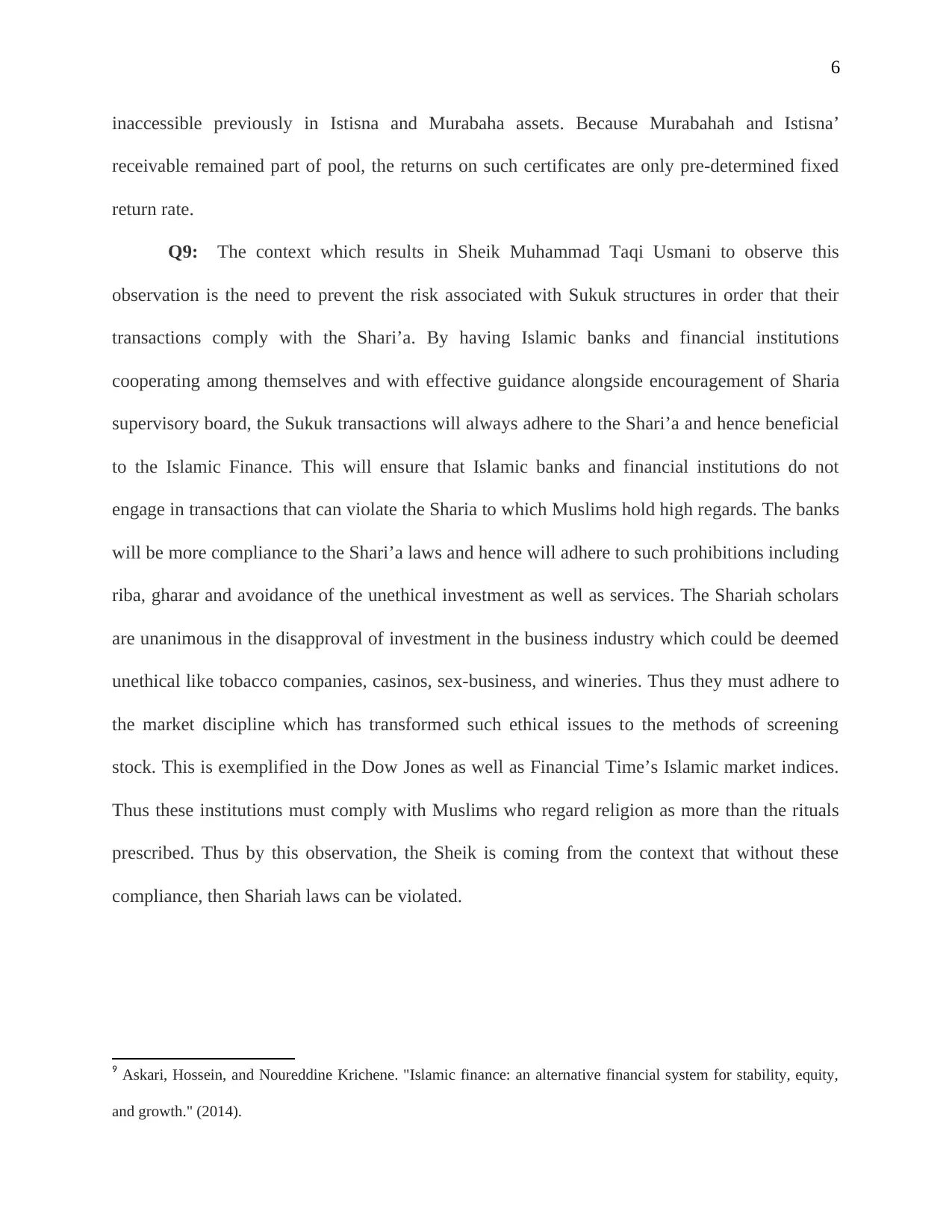
6
inaccessible previously in Istisna and Murabaha assets. Because Murabahah and Istisna’
receivable remained part of pool, the returns on such certificates are only pre-determined fixed
return rate.
Q9: The context which results in Sheik Muhammad Taqi Usmani to observe this
observation is the need to prevent the risk associated with Sukuk structures in order that their
transactions comply with the Shari’a. By having Islamic banks and financial institutions
cooperating among themselves and with effective guidance alongside encouragement of Sharia
supervisory board, the Sukuk transactions will always adhere to the Shari’a and hence beneficial
to the Islamic Finance. This will ensure that Islamic banks and financial institutions do not
engage in transactions that can violate the Sharia to which Muslims hold high regards. The banks
will be more compliance to the Shari’a laws and hence will adhere to such prohibitions including
riba, gharar and avoidance of the unethical investment as well as services. The Shariah scholars
are unanimous in the disapproval of investment in the business industry which could be deemed
unethical like tobacco companies, casinos, sex-business, and wineries. Thus they must adhere to
the market discipline which has transformed such ethical issues to the methods of screening
stock. This is exemplified in the Dow Jones as well as Financial Time’s Islamic market indices.
Thus these institutions must comply with Muslims who regard religion as more than the rituals
prescribed. Thus by this observation, the Sheik is coming from the context that without these
compliance, then Shariah laws can be violated.
9 Askari, Hossein, and Noureddine Krichene. "Islamic finance: an alternative financial system for stability, equity,
and growth." (2014).
inaccessible previously in Istisna and Murabaha assets. Because Murabahah and Istisna’
receivable remained part of pool, the returns on such certificates are only pre-determined fixed
return rate.
Q9: The context which results in Sheik Muhammad Taqi Usmani to observe this
observation is the need to prevent the risk associated with Sukuk structures in order that their
transactions comply with the Shari’a. By having Islamic banks and financial institutions
cooperating among themselves and with effective guidance alongside encouragement of Sharia
supervisory board, the Sukuk transactions will always adhere to the Shari’a and hence beneficial
to the Islamic Finance. This will ensure that Islamic banks and financial institutions do not
engage in transactions that can violate the Sharia to which Muslims hold high regards. The banks
will be more compliance to the Shari’a laws and hence will adhere to such prohibitions including
riba, gharar and avoidance of the unethical investment as well as services. The Shariah scholars
are unanimous in the disapproval of investment in the business industry which could be deemed
unethical like tobacco companies, casinos, sex-business, and wineries. Thus they must adhere to
the market discipline which has transformed such ethical issues to the methods of screening
stock. This is exemplified in the Dow Jones as well as Financial Time’s Islamic market indices.
Thus these institutions must comply with Muslims who regard religion as more than the rituals
prescribed. Thus by this observation, the Sheik is coming from the context that without these
compliance, then Shariah laws can be violated.
9 Askari, Hossein, and Noureddine Krichene. "Islamic finance: an alternative financial system for stability, equity,
and growth." (2014).
Paraphrase This Document
Need a fresh take? Get an instant paraphrase of this document with our AI Paraphraser
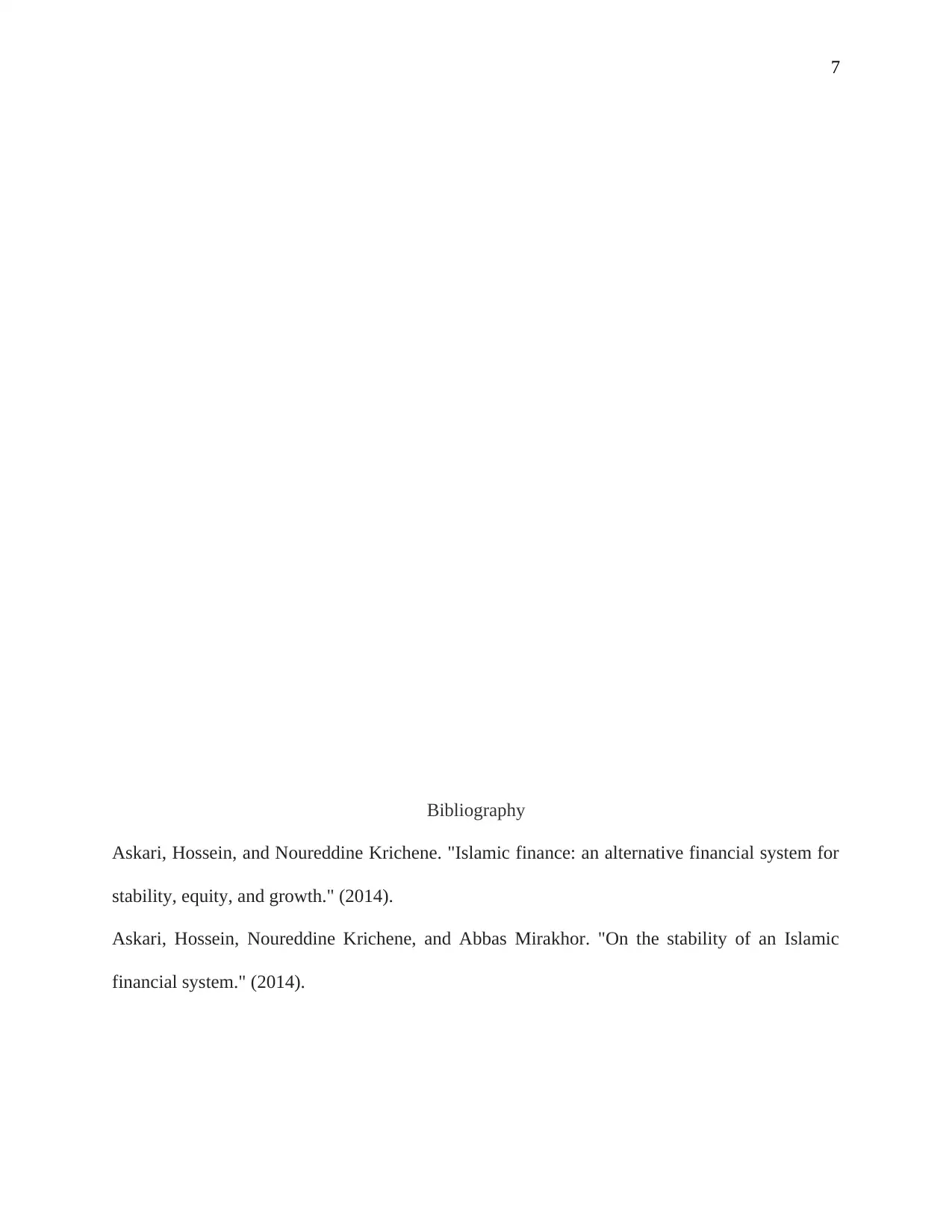
7
Bibliography
Askari, Hossein, and Noureddine Krichene. "Islamic finance: an alternative financial system for
stability, equity, and growth." (2014).
Askari, Hossein, Noureddine Krichene, and Abbas Mirakhor. "On the stability of an Islamic
financial system." (2014).
Bibliography
Askari, Hossein, and Noureddine Krichene. "Islamic finance: an alternative financial system for
stability, equity, and growth." (2014).
Askari, Hossein, Noureddine Krichene, and Abbas Mirakhor. "On the stability of an Islamic
financial system." (2014).
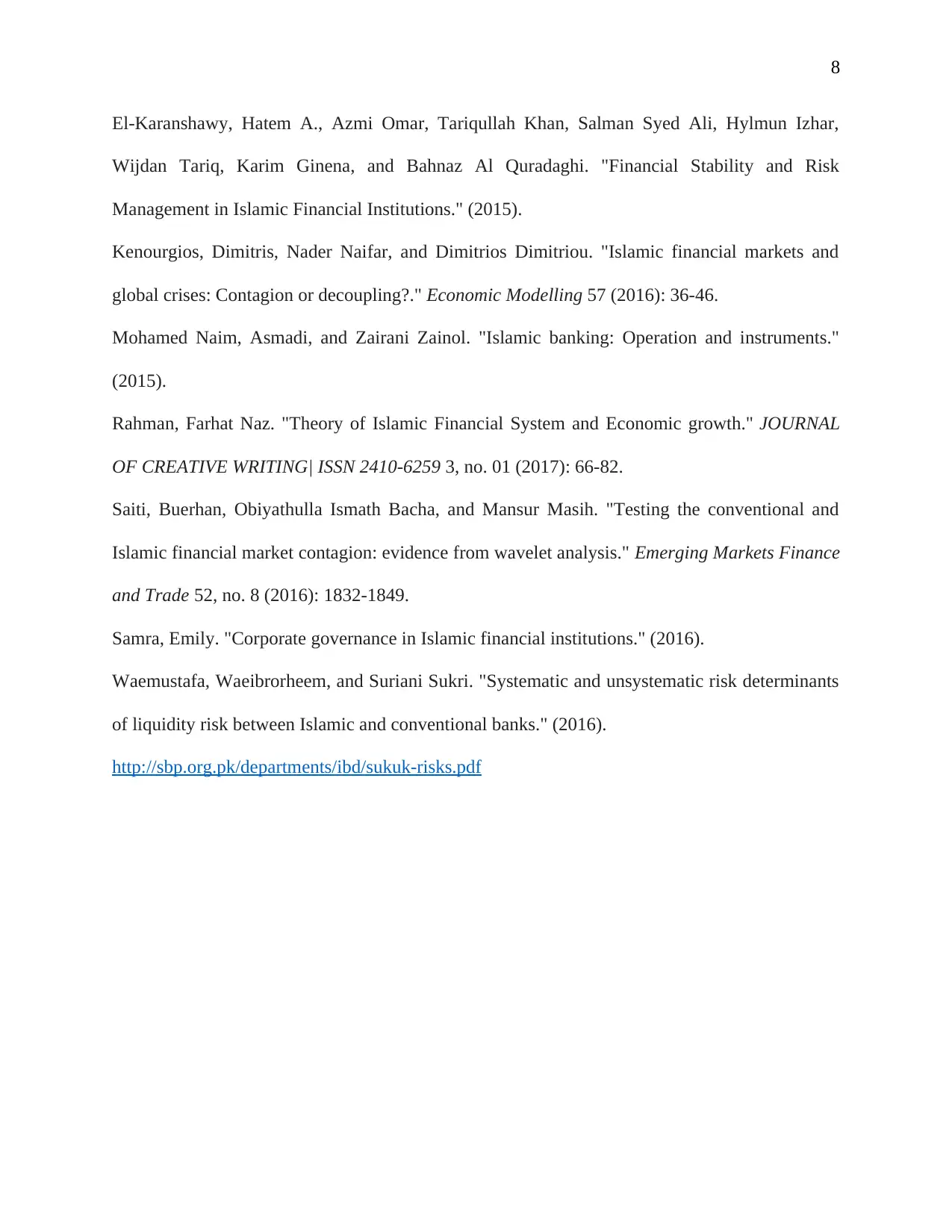
8
El-Karanshawy, Hatem A., Azmi Omar, Tariqullah Khan, Salman Syed Ali, Hylmun Izhar,
Wijdan Tariq, Karim Ginena, and Bahnaz Al Quradaghi. "Financial Stability and Risk
Management in Islamic Financial Institutions." (2015).
Kenourgios, Dimitris, Nader Naifar, and Dimitrios Dimitriou. "Islamic financial markets and
global crises: Contagion or decoupling?." Economic Modelling 57 (2016): 36-46.
Mohamed Naim, Asmadi, and Zairani Zainol. "Islamic banking: Operation and instruments."
(2015).
Rahman, Farhat Naz. "Theory of Islamic Financial System and Economic growth." JOURNAL
OF CREATIVE WRITING| ISSN 2410-6259 3, no. 01 (2017): 66-82.
Saiti, Buerhan, Obiyathulla Ismath Bacha, and Mansur Masih. "Testing the conventional and
Islamic financial market contagion: evidence from wavelet analysis." Emerging Markets Finance
and Trade 52, no. 8 (2016): 1832-1849.
Samra, Emily. "Corporate governance in Islamic financial institutions." (2016).
Waemustafa, Waeibrorheem, and Suriani Sukri. "Systematic and unsystematic risk determinants
of liquidity risk between Islamic and conventional banks." (2016).
http://sbp.org.pk/departments/ibd/sukuk-risks.pdf
El-Karanshawy, Hatem A., Azmi Omar, Tariqullah Khan, Salman Syed Ali, Hylmun Izhar,
Wijdan Tariq, Karim Ginena, and Bahnaz Al Quradaghi. "Financial Stability and Risk
Management in Islamic Financial Institutions." (2015).
Kenourgios, Dimitris, Nader Naifar, and Dimitrios Dimitriou. "Islamic financial markets and
global crises: Contagion or decoupling?." Economic Modelling 57 (2016): 36-46.
Mohamed Naim, Asmadi, and Zairani Zainol. "Islamic banking: Operation and instruments."
(2015).
Rahman, Farhat Naz. "Theory of Islamic Financial System and Economic growth." JOURNAL
OF CREATIVE WRITING| ISSN 2410-6259 3, no. 01 (2017): 66-82.
Saiti, Buerhan, Obiyathulla Ismath Bacha, and Mansur Masih. "Testing the conventional and
Islamic financial market contagion: evidence from wavelet analysis." Emerging Markets Finance
and Trade 52, no. 8 (2016): 1832-1849.
Samra, Emily. "Corporate governance in Islamic financial institutions." (2016).
Waemustafa, Waeibrorheem, and Suriani Sukri. "Systematic and unsystematic risk determinants
of liquidity risk between Islamic and conventional banks." (2016).
http://sbp.org.pk/departments/ibd/sukuk-risks.pdf
⊘ This is a preview!⊘
Do you want full access?
Subscribe today to unlock all pages.

Trusted by 1+ million students worldwide
1 out of 9
Your All-in-One AI-Powered Toolkit for Academic Success.
+13062052269
info@desklib.com
Available 24*7 on WhatsApp / Email
![[object Object]](/_next/static/media/star-bottom.7253800d.svg)
Unlock your academic potential
Copyright © 2020–2025 A2Z Services. All Rights Reserved. Developed and managed by ZUCOL.